Ever play a game of telephone when you were a kid? You start with a message, whisper it in someone’s ear, and by the time it reaches the end of the group, the message is completely distorted and oftentimes is no longer truthful. This is why it’s always so important to go straight to the source. “Believe nothing of what you hear, and only one half of that you see,” as the old saying goes.
The same can be said for learning or reading about a topic online. It’s critical to trace the info back to where it originated, whether that’s an Internet article talking about a new study (is the study cited and peer-reviewed?) or discussing the latest gossip in your town or social circle. Truth is so incredibly important when it comes to journalism, but sometimes the imagery associated with the points are so far off, you have to wonder how credible the source and other info is as well.
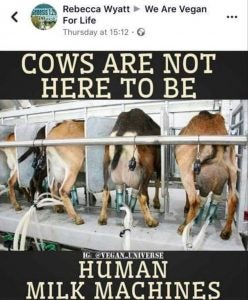
Oh dear. Notice anything off about this photo? Look closely. While your eye instantly goes to udders and milking equipment, the animals in that photo are not cows! They’re goats. So, are the messages they’re sending out about animal agriculture truthful? Probably not, considering “Vegan_Universe” would love for everyone to give up meat and dairy, and they don’t even correctly share an image of the animal in question. If the visuals are so off, the wording or article probably is as well.
I see this in the vegan animal-rights community more often than not. For example, one time I had someone look at my social media page and say I was a dairy farmer. But we aren’t dairy farmers … we are beef producers who raise Black Angus! That person looked at one of my images and automatically assumed we were a dairy, because they didn’t know there were differences in bovines. But Angus beef cattle are not dairy breeds! This is another example of that:
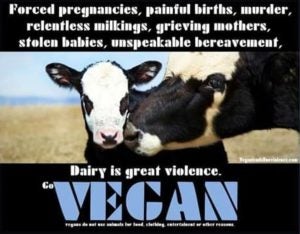
Milk isn’t cruel, but the least they could do is know what a dairy cow breed actually looks like … beef breeds and milk breeds look quite different.
Go to the source. Ask farmers about farming, and it isn’t usually right to assume things!
Here is another example of an image on social media that explains something completely wrong.
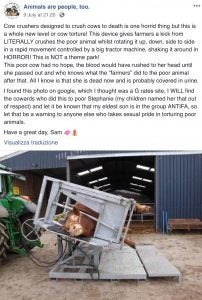
A “cow crusher?” For Pete’s sake! Thankfully the comments section of this post destroyed the nonsense associated with the bad image — though, unfortunately, it had quickly made its way through many vegan channels and even drew national mainstream attention in order to help debunk it. This isn’t used to crush cows … it’s a great tool to care for cattle’s hooves. Yes, cows get pedicures! This device also allows veterinaries to administer various types of care for the animals.
There’s nothing wrong with someone choosing to identify as vegan, but there is something wrong with maliciously lying (even in the name of satire) or refusing to remove a post after clearly everyone has proven you wrong.
Who else is wrong? Besides the vegan animal-rights activist groups, many in the anti-GMO camp seem fond of stretching the truth. Take for instance this one:
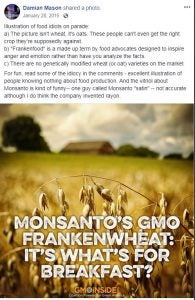
The problem here is there’s no such thing as (commercially available) GMO wheat, and this photo isn’t even wheat … it’s oats! So if they’re going to bash a product, let’s at least make sure that product exists first and they know what a crop even looks like.
Activist groups have an agenda or goal, but food companies sometimes do as well. And let’s just say that Organic Valley has not had a good week on social media. Check this out:
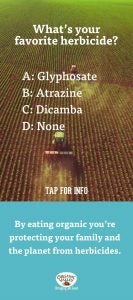
Wow. Thankfully, once again my faith in humanity is restored via the comments section. The radical activism in the anti-GMO movement has been called out for so many years, we appear to be making traction as a society to persuade food companies to knock it off with the misleading labels. But what’s interesting about this post from Organic Valley is if you look closely at the image, those aren’t even sprayers! They’re seeders. And why would a seeder be going over a field that clearly already has a crop in it anyway? Another interesting thing to point out is the weather patterns. Look at the way the mist is blowing from the top right seeder compared to the bottom left one. Their entire post makes no sense, from the bad information to the wrong equipment and Photoshopping. Organic Valley has been on my “do not buy list” for years, and this malicious Photoshop job just reiterates why I will never trust or support this brand.
Another brand putting up false flags is Hunt’s, who’s also been called out for images like this:
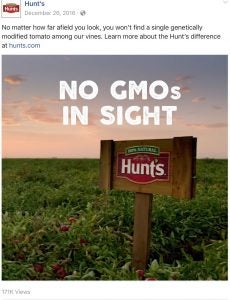
Well Hunt’s, as your now ex-customers have pointed out, there’s no such thing as GMO tomatoes — at least not in the biotech sense that the image is clearly alluding to! So I hope this field of “non-GMO” tomatoes is shark-free as well, as something that would never exist …
So there you have it. Just a few examples of activist groups and companies that have buried themselves in a hole for having blatantly wrong imagery and messaging. If something as basic as the use of a stock image can go so awry, where the offender won’t remove or edit the post, how can anything else they say or do be taken seriously? As a journalist, when someone proves me wrong I am quick to delete or edit the post to reflect accuracy and keep my reputation and integrity. It’s time these people do as well.
Michelle Miller, the Farm Babe, is an Iowa-based farmer, public speaker, and writer, who lives and works with her boyfriend on their farm, which consists of row crops, beef cattle, and sheep. She believes education is key in bridging the gap between farmers and consumers.



